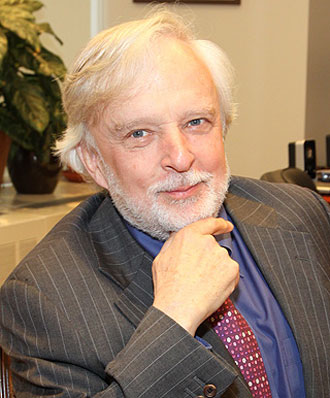Maxwell Perspective: Retracing History
July 7, 2012
From Maxwell Perspective...
Retracing History
A Maxwell benefactor has partnered with Documentary Film and History to tell the story of one man’s journey on the Underground Railroad.

Walter Montgomery, history buff and member of the School’s Advisory Board, recognized that the story of runaway slave John Jones would fit well in the type of film studied in Documentary Film and History.
Communities throughout upstate New York are known for their important role in the abolition movement and the Underground Railroad, serving as home to noteworthy historical figures including Harriet Tubman and Frederick Douglass. Now, Maxwell alumnus Walter Montgomery ’67 BA (PSc), a native of Elmira, New York, is helping spread an equally fascinating story through the master’s degree program in Documentary Film and History (DFH).
On April 14, Syracuse Stage hosted the premiere of 300 Miles to Freedom, a new film executive-produced by Montgomery and produced by Richard Breyer, co-director of the DFH program, with his film-making partner, Anand Kamalakar (an SU alumnus). The film tells the widely unknown story of John W. Jones, a Virginia slave who walked from Leesburg to freedom in Elmira. Once settled in Elmira, Jones became an active agent on the Underground Railroad and is credited with helping more than 860 fugitive slaves to freedom. At the same time, he served as the sexton of Elmira’s First Baptist Church and gained responsibility for burying the dead, which included Confederate soldiers from a Union prison camp near Elmira. Jones was paid $2.50 by the federal government for each Confederate soldier buried, enabling him to purchase a farm and become the wealthiest black man in the area.
Having grown up in Elmira — a key stop on the Underground Railroad between Philadelphia and Ontario — Montgomery, an avid history buff, was well aware of the town’s abolitionist legacy. But he had never heard of Jones until stumbling upon an article about the ex-slave a few years ago. Montgomery next visited the Elmira cemetery where the Confederate soldiers are buried and learned about efforts to preserve Jones’s home as a museum.
“It’s a story that needed to be told, and this was a perfect fit.”
-Film benefactor Walter Montgomery
Montgomery — partner in the New York City-based strategic financial communications firm Robinson, Lerer and Montgomery — is also a member of the Maxwell School Advisory Board, and it occurred to him that Jones’s story would be an ideal project for the School’s new master’s program in Documentary Film and History (DFH), a joint venture with SU’s Newhouse School. The program, launched in 2007, prepares students for careers in documentary history or for scholarly careers studying film. It is co-directed by Maxwell historian Scott Strickland and Newhouse filmmaker Richard Breyer.
Montgomery discussed the project with Breyer, who has a successful history of distributing his work through PBS and other such avenues. They agreed the project was worthwhile, and Montgomery provided the funds.
Last June, Breyer and Brooklyn-based filmmaker Anand Kalamakar, an SU alumnus, retraced the 300-mile route from Leesburg to Elmira, visiting sites that included black churches, plantations, and the Leesburg farm where Jones’s mother and other relatives are buried. “We were on his ground,” says Breyer, who shared rough cuts of that footage with students in the DFH program to get their input.
The 40-minute documentary tells Jones’s story through characters the filmmakers met along their journey — historians, ferry boat captains, ministers, farmers, restaurant and gas station owners — weaving voices and images of the past with those of the present.
That process “provided students a hands-on, direct, transparent model of exactly what each one of them will go through themselves on their thesis project,” says Breyer. “How you design a story like this — especially one that goes back in time when the protagonist isn’t with us any more — is always a creative challenge. Not to mention the struggles of the post-production process, which includes editing, structuring, and layering new materials.”
To be in a present-tense experience with filmmakers working on a real project was beneficial, says student Laura Jacubowski. “It gave us an opportunity to be part of the collaborative process that is documentary filmmaking before we’ve even graduated,” she says.
Students helped organize premieres of the film in Syracuse and Elmira, both of which benefitted charities (including the Chemung Valley Historical Society). In addition to local showings, 300 Miles to Freedom will be distributed for educational use and maybe to PBS.
“It’s a story that needed to be told, and this was a perfect fit,” says Montgomery. “There are few schools in the country where you could join together an interest in history, public affairs, and documentary filmmaking as professionally as you can at Syracuse because of Newhouse and the Maxwell School.”